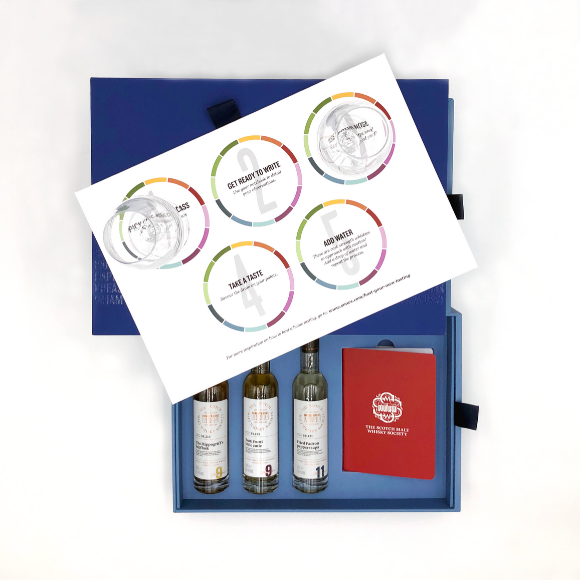Glengoyne
First Society bottling in 2005.
Glengoyne is situated little more than a dozen miles from Glasgow, just south of the village of Killearn, in 'Rob Roy' country. It is an attractive distillery with a traditional look and feel to it, and despite its comparative proximity to the city, the location in a wooded glen at the foot of Dumgoyne Hill could hardly be bettered. The Glengoyne Burn flows from Dumgoyne Hill into the distillery site by way of a dramatic, 50 foot high waterfall and is used for cooling purposes before being sent on its way to nearby Loch Lomond.
Glengoyne was first licensed in 1833, but it is believed that distilling on the site predates that and certainly the area was once a hotbed for smuggling. In 1866 local historian Guthrie Smith wrote that during the early years of the 19th century, "the smoke of 13 illicit stills" was visible in the vicinity.
The distillery was built by George Connell, who leased the land on which it was constructed, and the licence was held by members of the Maclellan family for many years. Originally christened Glenguin, the distillery was known as Burnfoot at the time when it was bought by lang Brothers Ltd in 1876. They changed the name back to Glenguin, or Glen Guin, and the present spelling was adopted around 1905. A programme of modernisation and expansion was undertaken following the acquisition of lang Brothers Ltd by the Robertson & Baxter Group in 1965 and a third still was added during reconstruction work in 1966/67.
One of the original warehouses built by George Connell still stands today, and serves as the shop and visitor reception area, which plays host to around 35,000 people each year. Eight working warehouses have a capacity of nearly two million litres, or 4.5 million bottles of spirit. The geological Highland Fault line which separates lowland and Highland distilleries runs below the A81 road from Glasgow to Aberfoyle in front of Glengoyne. This means that although the whisky is made in the Highlands, it matures in the lowlands, as Glengoyne's warehouses are to the south-west of the A81. Robertson & Baxter is now part of the Edrington Group and under their ownership, a great deal of Glengoyne found its way into langs Supreme and other blends.
Then, in April 2003, the distillery and a significant amount of maturing stock were acquired by Ian Macleod Distillers Ltd. Although the firm was founded in 1936 by Leonard Russell, it had never owned a distillery before Glengoyne. The third generation Leonard Russell is currently managing director of the Broxburn-based blending and bottling business, best known for its Isle of Skye blended Scotch whisky.
The purchase of Glengoyne has given Ian Macleod a 'flagship' single malt with clear growth potential, the option for reciprocal trading of new fillings, which is attractive to any blender and a particularly picturesque focal point for the business.
The distillery boasts a capacity of 1.2m litres per annum and Leonard Russell says "We've doubled distilling output and we're still not working at 100 per cent capacity. We've increased the number of mashes per week and we still have nine whisky-makers as before. "The stocks were the biggest part of the acquisition and we continue to make whisky exactly the same way at Glengoyne, using Golden Promise barley." Low in yield but high in quality, Golden Promise has been largely abandoned by distillers, with the exception of Glengoyne and The Macallan. Not only is the variety of barley unusual, but so is the fact that during malting no 'peat reek' is introduced. Barley destined for Glengoyne is dried solely using warm air, as has long been the case.
Given the use of unpeated malt, Glengoyne is perhaps stylistically closer to a Lowland than a Highland single malt and it is sometimes likened in character to the triple-distilled Auchentoshan. Indeed, although standard 'double' distillation has long been the norm at Glengoyne, after visiting the distillery during the 1880s while researching his epic The Whisky Distilleries of the United Kingdom, Alfred Barnard wrote "We may here mention that the Spirits are distilled three times by the various processes of working in the Distillery." Ian Macleod Distillers Ltd use the promotional slogan 'The authentic taste of malt whisky untainted by peat smoke'. "'The real taste of malt' is our whole platform for marketing the whisky," explains Leonard Russell, noting that the lack of peat allows the true character of malt to come through in the whisky, described as "clear, bright, subtle, yet delicate".
Certainly there is a creamy, fruity, floral, malt character to the finished product and its undoubted smoothness is attributed by its makers to the fact that the three stills with their distinctive 'boil balls' are run very slowly. Now Society members may make up their own minds about the subtle delights of Glengoyne....

